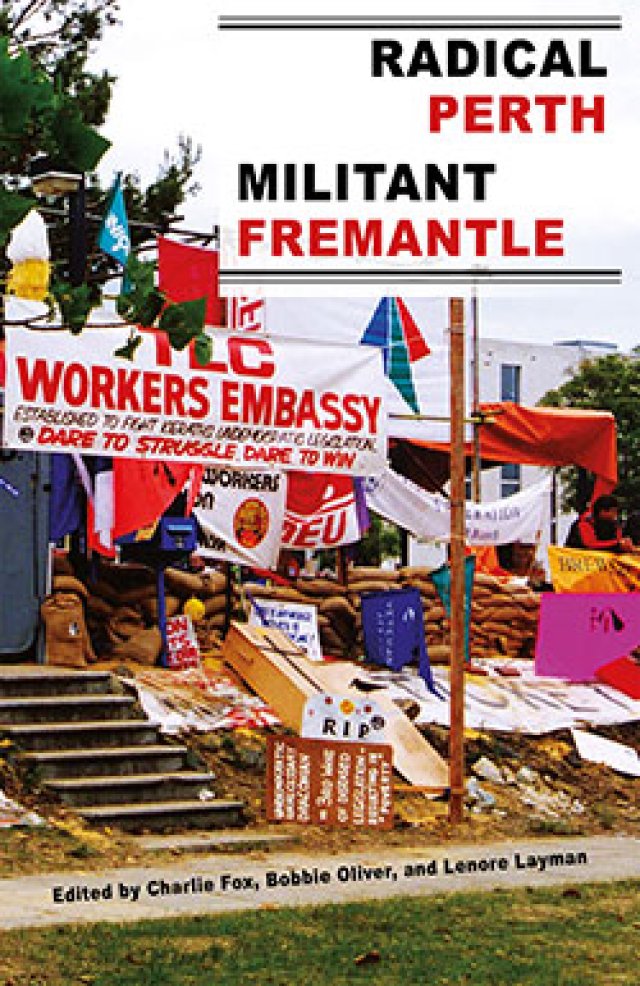
Radical Perth, Militant Fremantle
Edited by Charlie Fox, Bobbie Oliver & Lenore Layman
Black Swan Press
Curtin University, 2017
283 pages, $30.00
When we think of Western Australia, we generally do not think about left-wing politics or radical actions. WA’s unique history, demographic, natural resources and generally prosperous economic conditions had always shaped a strong sense of a place not especially inclined to serious challenges to the status quo.
Such, in particular, is the reputation of its capital Perth — at least compared to eastern Australia.
The recent release of a series of “Radical” books looking at often untold “radical histories” of Melbourne, Brisbane, Sydney, and Newcastle have prompted local left-leaning historians to question whether there was scope to produce one for Perth as well.
This was a challenging undertaking from the get-go. Local historians who had come up with this idea were discouraged by the common sentiment that there just wouldn’t be enough material for such a book.
But the historians were undeterred and undertook the mammoth undertaking of gathering a collection of historical accounts.
Leading the charge were three historians with a suite of research accolades under their belt. Charlie Fox was a historical researcher at the University of Western Australia until his retirement in 2011; Bobbie Oliver is an Associate Professor at Curtin University, with specific interests in Australian and labour history; while Lenore Layman is a Western Australian historian as well as an Associate Professor at Murdoch University.
These three editors invited interested members of the public to contribute to the project. The final product showcases work from a dozen contributors with distinct writing styles and historical specialties.
With the myriad of contributors coming from different left-wing backgrounds, the essays cover very diverse struggles. These include: workers’ rights; women’s liberation; LGBTI rights, Aboriginal struggles; anti-racism; environmental campaigns and opposition to various wars and militarism.
The stories show how the struggles from the past have had a considerable influence on similar events today. For example, the fact that the May Day rally in Fremantle is the biggest annual event in the modern-day radical Perth calendar can be appreciated more richly after reading the chapter, “The Workers’ Day? May Day in Perth and Fremantle”. It provides background to how and why this event was able to grow to the extent it has today.
The book also gives an insight into how and why some unions have developed as more militant and radical than others. For example, the article “War on the Waterfront: The 1998 MUA dispute” demonstrates the battle between the Maritime Union of Australia and the federal government after the government’s full-scale assault on the union and the maritime workforce.
Some of the articles highlight the importance of solidarity from across different sectors of society. For example, in “Australia’s First Urban Land Rights Campaign: Goonininup versus the Old Swan Brewery”, which is known informally as Australia’s first urban land rights campaign, several unions got behind the cause. This helped prolong the campaign.
Conversely, and tragically, when the unions were pressured to stop offering their support, the campaign ultimately failed.
Two other chapters from the book that emphasise solidarity are “Solidarity Park: the Workers’ Embassy” and “Occupy Perth”. “Solidarity Park” looks at the area next to the state parliament that was occupied by unionists and supporters in 1997 as part of the campaign against anti-union laws.
“Occupy Perth”, on the other hand, was a much more recent affair when many different activist groups came together in 2011 to challenge the Commonwealth Heads of Government Meeting and send a message that it was not okay for a minority to hoard the majority of the world’s wealth. It was, more than anything, a richly symbolic gesture of solidarity.
The authors employ the terms “radical” and “militant”, which appear in the title, in a flexible fashion, taking into account the context of the time and communities involved. Two examples described in the book are the battles by the Chung Wah Chinese Association and the Women Against Nuclear Tests group.
The approach and actions of these groups might not be perceived as “radical” in the way many on the left might define it, but both were radical in the context of that time.
The book also covers less explicitly political movements, such as the “Snake Pit” — a place where young people congregated to dance and enjoy contemporary music. As harmless as it sounds, authorities shut it down in the early ’60s, as it was perceived to be a sign of rebellion.
Another example from an unexpected direction is the chapter titled “The Red Dean, the Sixties and Perth’s Rock Masses”. This describes the progressive rock events that took place in the late 1960s and early ’70s at St Georges’ Cathedral, of all places.
Other broader social issues and phenomena are looked at, including a chapter about a non-profit farm and community garden, titled “Hope in the Wasteland: East Perth’s City Farm”. Another chapter looks at Perth’s mental health facilities, titled “Closing the Asylums: De-institutionalization in Perth”.
One thing that stands out in all the chapters is the author’s honesty, as well as the personal insights provided. Most do not shy away from critiquing strategies and tactics used in the stories they depict.
The stories often describe how traditional left-wing activities such as protests, picket lines and rallies were used in conjunction with other tactics, such as petitioning and fighting on legal grounds.
The book focuses on the often intense and radical struggles from the past. With disturbing developments internationally and worsening inequality and other attacks of various sectors in this country, we can expect new struggles in Perth and Fremantle to develop and thrive.